Many thanks to SWLing Post contributor, TomL, who shares the following guest post:
YouLoop Picnic Table Report
by TomL
So, I finally got around to testing my Airspy YouLoop after the long shipping delay from China. It is simple in concept and will not repeat what others have written about it in previous articles. I find it a useful loop antenna for portable operations and sometimes for noisy home use. This report is focused on my usual field location from a Northern Illinois county park picnic table.
Setup
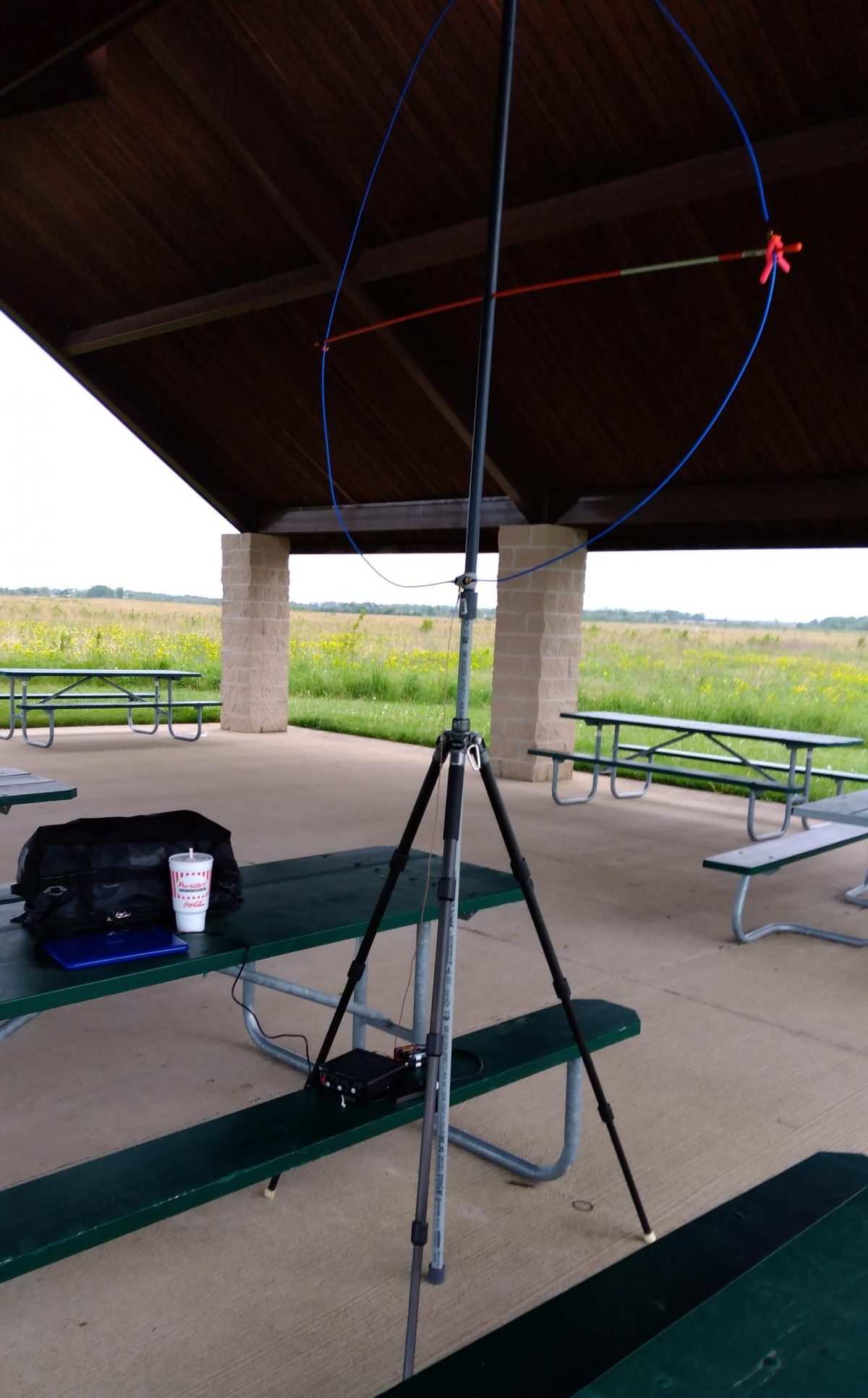 As you can see from the setup photo, it all fits into a backpack except for the two PVC pipes and crossbar which are easy carried. I modified my YouLoop to use the 2 meter transmission line as one half of the loop. The other half consists of the two shorter wires connected with a simple female-to-female SMA connector. This doubles the circumference of the loop and gives it a bigger capture area.
As you can see from the setup photo, it all fits into a backpack except for the two PVC pipes and crossbar which are easy carried. I modified my YouLoop to use the 2 meter transmission line as one half of the loop. The other half consists of the two shorter wires connected with a simple female-to-female SMA connector. This doubles the circumference of the loop and gives it a bigger capture area.
Crossbar
Because my setup is bigger than usual, I had to find a lightweight cross member to aid the solid conductor wire from sagging. I found just the thing in a larger-than-normal 6 foot fiberglass driveway snow marking stick sold at the local hardware store. I cut the tip off to make it 5 feet (Because, the loop as I configured it is 4 meters circumference, so, 4*39.37/Pi = Diameter in inches). I then drilled a 5/16th’s inch hole through the middle of the ¾ inch PVC threaded pipe I had from a previous project and fit the fiberglass stick through it as the crossbar. This is a special PVC 4 foot nipple pipe I had special ordered a long time ago when mounting a previous (heavy) Ferrite-Sleeve loop antenna.
Loop Mounting
Screwed onto both ends of the 4 foot nipple are threaded-to-coupler adapters also found at the hardware store. The adapter allows me to attach easily to the ¾ inch 5 foot long PVC pipe held by my trusty carbon fiber tripod below. This 5 foot pipe is held loosely by the tripod so I can grab the pipe and turn the whole loop mounted above. The result is not perfectly circular and there is room for improvement. I find it to be highly directional nonetheless and easy to turn. The phasing connector of the YouLoop mounts at the top and for now I am just using two medium sized cable ties to a long screw near the top for tension. I do not want to glue the connector to the top since this YouLoop may get used in other configurations in the future.
The Bottom connector for the radio input is held nicely with a couple of velcro wraps.
The wire from there goes to the usual setup of Palstar amplified preselector with battery pack and Airspy HF+, which goes into the USB port on the small Dell laptop. After some initial problems with a non-functioning HF+ and rebooting a few times, I was finally able to get a signal. At first I thought it was the antenna but the error condition acted the same way whether the antenna was connected or not. It could be that my HF+ is starting to exhibit the first signs of failure, which I have read about from complaints on the internet about the reliability of SDR’s used in the field. I may have to bring along my SDRPlay SDR2 just in case! In other words, don’t depend on computer hardware and software to work (especially if you happen to go on vacation and have no backup radio!!). I also have a couple of portable non-SDR radios I could bring with me as well. Enough said.
Using It
The screen of the laptop shows a very nice black background, very quiet, and a moderate signal level of WRMI on the 31 meter band. I did not have the time or processing power for real Data captures, so all I have to share are less optimal MP3 files. The signal level is somewhat low. I think this is typical for a single-wire loop antenna and seems adequate. I did have to crank my Palstar preamp to maximum the whole time while on shortwave (my Wellbrook amp would probably work slightly better). On mediumwave, the gain seemed more than adequate (I don’t have any recordings of that band at this time, maybe a future article).
Directionality is very good and usable across a very wide range of frequencies! It certainly worked well up to the 25 meter band where I started to notice a drop off of nulling ability. And this is good despite my lack of perfect circular mounting of the wire. Even though my county park is a “Forest Preserve” and not meant to have any development, there is increasing noise in the neighborhood and I find the loop to be very useful in cleaning up some background noise (as well as noise coming from the laptop!). This is especially seen with the Voice of Iran broadcast in French. The weak signal was aided by moving the loop to balance the signal level to local noise.
The loop is a bit flimsy using it this large. Keeping the connectors tight may be a problem in the future if subject to a lot of wind. I think you will find the smaller (usual) setup in the instructions to be less of a problem. My plastic clips at the sides of the crossbar and the plastic tie downs at the top are not optimal and will need something better (in other words, it would help if I had a better mounting for the wires). Also, the tripod definitely wanted to tip over as a storm blew past, so I need to make sure I tie down one or more legs to the picnic table in the future!!
Final Thoughts
In summary, this is a very useful loop for portable operations since it fits easily into a backpack. Mounting it in a repeatable manner will need some experimentation. Performance is good with usable nulling at a wide range of frequencies. Signal strength is moderate, so a good preamp is necessary in order to boost the signal into the sweet spot of your receiver RF stage. Parts quality is good, but the wire is thin solid conductor, so do not kink/fold it!. The connectors and housing for the phase change and balun are very small, with non-waterproof plastic housings that can be easily abused, so take care of them. The whole kit is small to pack and lends itself to experimentation. Highly recommended given its limitations.
Furthermore, I feel my old, original 14-inch “crossed-parallel loop” did as good a job as this larger diameter YouLoop. I wonder how the YouLoop can be modified to create a larger gain using, say, two or more wires in parallel (perhaps a future article!)? Generally, the deeper the loop design, the higher the gain. The YouLoop potentially could be a better performing, more portable version if I can replicate using more turns of wire. Although it is in disrepair now, pictures of my old 14-inch loop are found here, and also here.
Sample Recordings
Here are a bunch of sample recordings to enjoy, some of which are unique to shortwave radio and found no where else:
9830 kHz, Voice of Turkey
10000 kHz, WWV
9395 kHz, WRMI
9420 kHz, Voice of Greece
11760 kHz, Radio Habana Cuba
11780 kHz, Radio Nacional Brazilia
11940 kHz, Radio Nationale Espana
7193 kHz, W3M – special Amateur Radio event to celebrate the birthplace of Memorial Day (Boalsburg, Pennsylvania)
7230 kHz, Voice of Iran (French)
7315 kHz, Voice of Vietnam, from WHRI-1 transmitter
7350 kHz, Radio China International, in English from Kashi PRC
7375 kHz, Radio Romania booming in from Romania
7490 kHz, WBCQ (Spanish) from Monticello ME (guide says only 50 kw but sounded more than that)
6180 kHz, Radio Nacional Brazilia
6070 kHz, CFRX Toronto – discussion about some people with ashes of relatives in the home
6115 kHz, WWCR Nashville TN – discussion about Jesus saving a young woman from Satanic ritual abuse as a child
5850 kHz, Radio Slovakia International from WRMI booming in as usual
73’s & Happy Listening,
TomL
Thank you, Tom, for sharing your field-portable SDR setup! I like how you’ve made an inexpensive and packable support system for the larger diameter YouLoop. While I’ve yet to design a similar system around the YouLoop, I really should. I’ve always believed that for both SWL and ham radio field-portable operations, a self-supporting antenna system is a must as it gives you ultimate flexibility to cope with variable site conditions.
Click here to check out Tom’s previous guest posts and portable adventures!

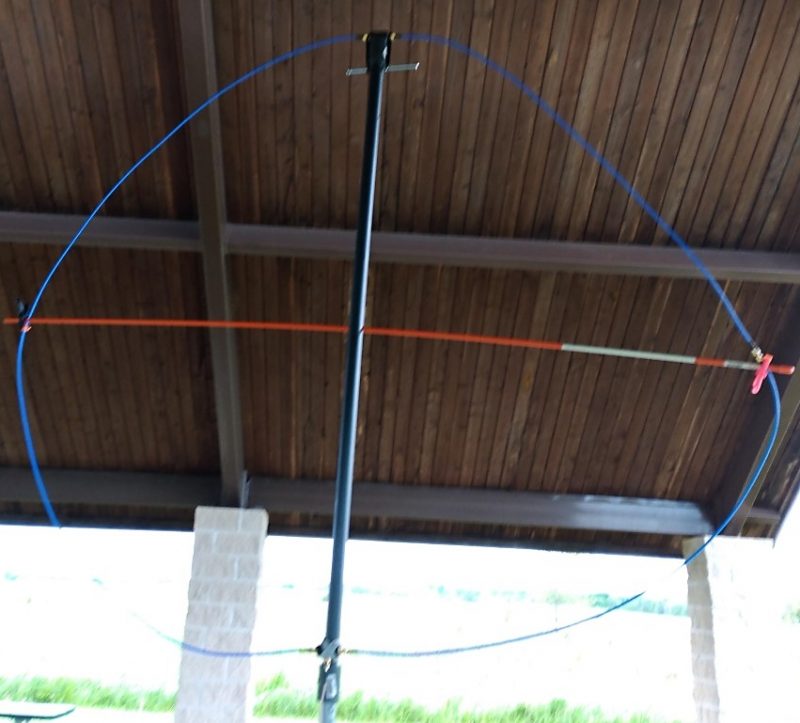
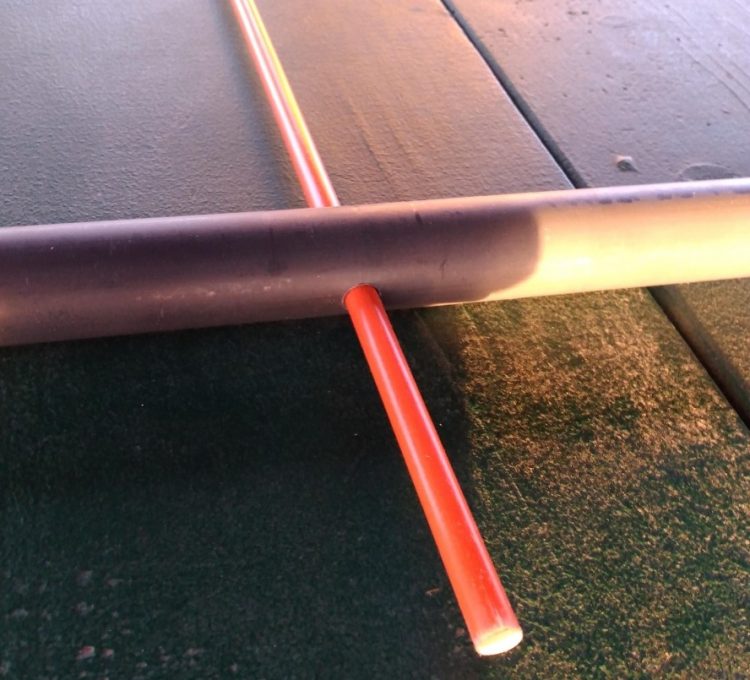
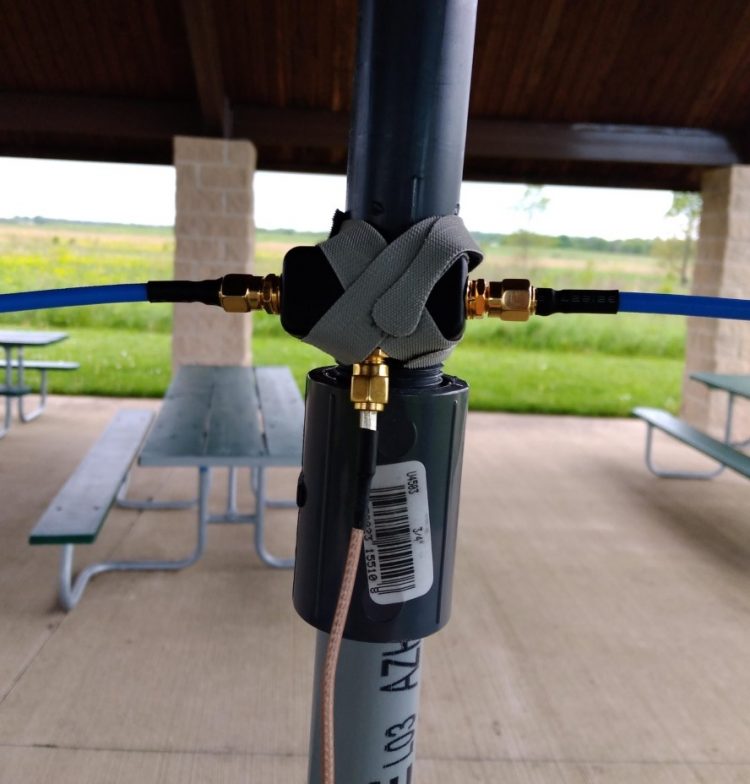
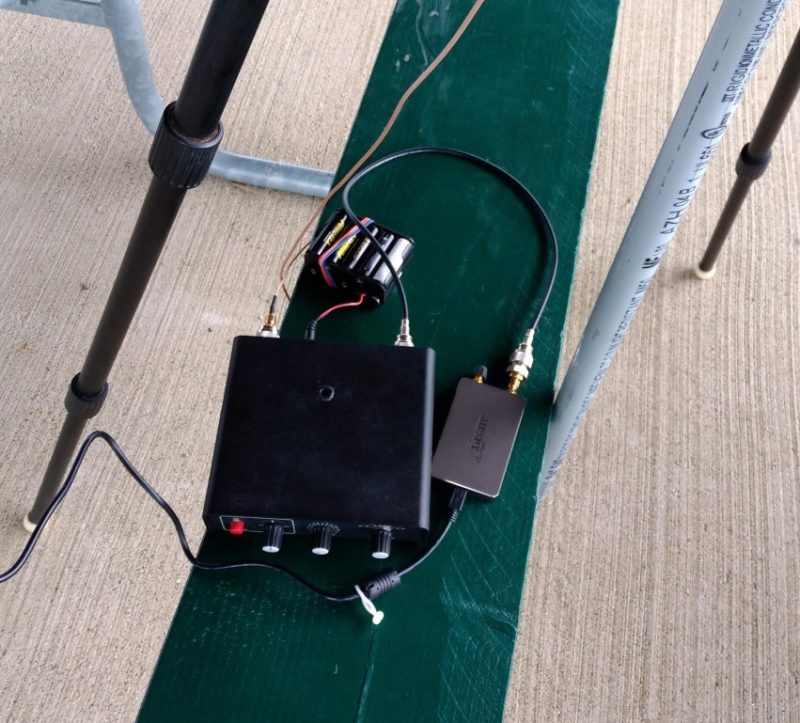
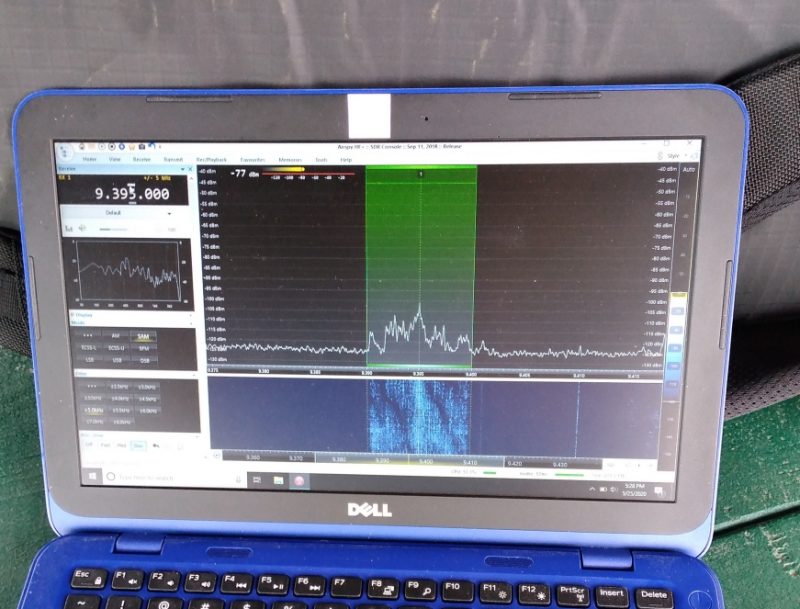
Hey Tom, I don’t think the samples identified as “Radio Nacional de Brasilia” are really from Brazil, since they are spoken in Spanish and Radio Nacional has no programs in Spanish.
My 148′ coaxial “shielded” loop-on-ground antenna:
https://www.hfunderground.com/board/index.php/topic,29940.msg114696.html#msg114696
Please excuse the crude paint.net drawings. 😉
BTW it probably should be called a loop-in-ground antenna these days due to pine needles, leaves, shifting sand, etc. Still works fine for my desired purposes.
I have routinely used the antenna for LW up through mid HF. There is discernable roll off above ~10MHz and substantial roll off above ~15MHz. I have a preamp inline if needed, but it is usually only used at the higher HF frequencies assuming I am too lazy to change to a different antenna.
Robert … did I understand your post correctly ? Is that coax loop laying on ground ?
If so here’s something you may try: change the top gap connection as the one of the NCPL (see the past links here for details), then modufy the (or add a) 9:1 feeding balun (KK5JY design) by adding a center tap to the antenna (high Z) side winding and connect the tap to the shield ground; I’d be really curious to hear if and how such a mod will affect your coax LoG performances
Yes, it is flat on the ground, or actually more like in the ground at this point.
The coaxial design is to (hopefully) balance how the loop is feed. W8JI has lots of great info on loop design and feeding on his site.
Given the decent balancing thus helping limit differential and common mode issues, there is not much need for an isolation transformer at the feedpoint. I have tried it with 1:1 and 4:1 baluns, too. No significant change in performance and frequency response. Now I just have some snap ferrites on the feedline, plus an 1:1 isolation choke back at the receiver largely just because it was already inline there.
At this point, it would be too troublesome to dig it up for modifications, plus I have multiple other outdoor antennas available. That said, it has been working fine for my purposes for many years. I deployed it long before the current LoG fad.
I see (and understand), well, I was just suggesting to try the different wiring since it would make the resulting loop electrically longer, so it may give you better performance on lower frequencies, but then, it probably was just a crazy idea 🙂
Your idea is sound. Just too much trouble to try it with the existing antenna. 😉
I have a YouLoop currently hanging in a window as a backup indoor antenna when storms roll through the area. At some point I might try switching out its coax elements to make a much larger loop, including trying it on the ground as a portable antenna.
Last summer I made some LoG experiments with a simple 60ft loop I usually throw into trees (which is always a good option for field trips as long as there are some trees). These experiments were surprisingly successful even with the loop in its passive form (with a 9:1 balun for bandwidth, don’t ask) . Provided the receiver has the needed sensitivity/noise profile, even the reduced voltage coming out of that loop was surprisingly sufficient and the simplicity of just laying your antenna onto the lawn is hard to beat. With a loop amplifier (Bonito ML-200) instead of the odd balun, the loop delivered more signal but no real advantage over the passive version. It does feel awkward and it’s likely not ideal for picking up borderline faint signals from the other end of the world but the added noise resilience could also be just what you needed to pick up such a signal, if your environment is noisy.
“the simplicity of just laying your antenna onto the lawn is hard to beat”
exactly so; putting the LoG in operation just means laying down the wire (possibly using some stones/pieces of wood/weights/stakes to keep the wire in place) and connecting the small balun and the coax feedline, and once in place the antenna will be invisible, people may step over it w/o even noticing there’s an antenna 🙂
“with a loop amplifier (Bonito ML-200) instead of the odd balun, the loop delivered more signal but no real advantage over the passive version”
been there, adding a preamp have a negative effect on SNR which is the key point in using the LoG, as for “weak signals from the other side of the globe”, don’t underestimate the LoG, sure it won’t make miracles, but while signals won’t come in booming, they WILL come in and even if there are a whisper they’ll be readable (again, personal experience), the only changes I made to the original KK5JY design was adding some ferrite chokes to the feedline, not really needed, but I prefer the “belt & suspenders” approach, also, willing to use the LoG for MW bands one may just use a longer wire (than the size indicated by KK5JY), that would improve signals on lower frequencies (but you’ll loose performance on the higher ones), but for details it’s better looking at the informations found on Matt’s (KK5JY) website
I believe that pairing a “LoG” (for RX) with a “squidpole” (for TX) could make a quite good portable setup for DXing (e.g. POTA or the like) on the 160 to 40 meters “top bands”
Hi Andrew,
I didn’t mean to sound like I underestimate the LoG concept . 🙂 My careful assumption that the LoG may not always be ideal for weak signals was based on the fact that I never (directly) compared my LoG contraptions to some comparable regular assembly. What I did have though was a “reference antenna” – simply the whip antenna on my S-8800, which also has an antenna switch. The S-8800 is quite sensitive with just the whip and on my quiet beach listening post it’s all I need to have fun playing radio, even when the condx are as bad as they usually are currently.
I will explain later why this is important, however, I just remembered that I did shoot some video footage when I made these experiments, here’s the passive setup:
https://youtu.be/qva1vmdmUqY
I think it’s not necessary to explain when the whip and when the LoG is active – the LoG beats the whip big time despite being pretty big and the frequency being pretty high (WWV 15MHz).
Here’s the active version on 13,270 and 10,051 Khz (Gander Radio):
https://youtu.be/1L4bKuTs4hU
“once in place the antenna will be invisible, people may step over it w/o even noticing there’s an antenna ?”
Been there too, I tried my LoG contraptions both a few miles inland and on my beach listening post and that’s where I had to ask the driver of some camping van to not park his vehicle on my antenna. There’s plenty of space and I park my car way off any spot where people usually park their cars so I didn’t really anticipate that kind of herd instinct. 🙂
You can probably imagine the reaction – eyebrows were raised and I was looked at as if they thought I’m trying to contact the afterlife with my invisible antenna. Once they relocated their RV they saw the wire and the rather technical looking setup. The guy looked curious and was reckless enough to ask about the purpose of that contraption, so I gave him a little lecture. I think he understood that an antenna on the ground is unusual and he seemed to be a bit surprised when I turned up the volume on the radio and explained that the buzz, the ticking and the voice announcing the time was coming from 7,700 kilometers away but I think I could read in his face that he didn’t understand why anyone would want to try that anyway.
I think next time this happens I’ll try the “afterlife” story . 🙂
Anyway, here’s another video showing the active setup (and that van!), receiving (I think) Radio Marti from Greenville:
https://youtu.be/QzSTNHhk4Pk
Please note that I deliberately chose frequencies in the range where bigger loops are said to roll off badly, and not the range where any loop really shines anyway. Apparently the LoG is not so bad up there either, which is to some degree due to the odd balun I used there, but not entirely.
That’s where the aforementioned “reference antenna” plays a role again: I have put up the ML-200 with its stock 10m wire in the conventional way (delta loop – apex down) and with a rigid 80cm loop at that place several times and – to my dismay – it was never (!) better than the whip at or above 10MHz, at best it wasn’t worse!
By coincidence, I have that on video too (WWV 10 MHz 5:00am local in summer last year):
https://youtu.be/kGw0B96X_CA
If you see my finger going up, it’s the whip, finger going down = ML-200+10m loop but it’s pretty obvious again, the loop is lacking signal.
Now the passive LoG with twice the lenght of wire beats the whip easily, and – here it comes – the very same wire on the same ML-200 (w/o the odd balun) as a LoG does too. So there is apparently semi-hard evidence that some arbitrary loop contraption used as LoG is more than just some lazy way to put it…erm.. not up, and that loop aperture may not necessarily equate to “smaller loop = better on high frequencies” (but that certainly applies to much larger loops resonant at the top bands). So yes, it is an extremely interesting and extremely easy to investigate receiving antenna concept! 🙂
73, Ollie
Ollie (aka “13dka”), no problem at all, I understood your point, and by the way, thanks for the reply and for the very nice videos !
As for the LoG something I directly experienced, time ago (two summers ago, if my memory is serving me) was listening to the radio, using a LoG, while there was an ongoing thunderstorm at some km from my spot; with the LoG there was almost NO noise from lighthnings (in the distance), can’t explain the reason for such a behavior (to be honest didn’t investigate), yet it’s another interesting “feature” of the LoG antenna 🙂
A word to those considering ordering a YouLoop: apparently they are selling more than can be produced, and when I ordered mine 3 weeks ago, there was no indication on the AirSpy.us web site that they were back-ordered. When I inquired several days later, I was told a bug in their site software made it a problem to label the loop as such, and new stock was expected “any time now” (there is now an “expect extended ship times” comment). Its been over 2 weeks since that email, and there has been zero communication from them since then, including not responding to a follow-up email I sent a week ago. At this rate, I would recommend ordering from a more responsive seller. Again, this relates to AirSpy.us, NOT AirSpy.com.
I ordered from airspy.us and there was a one month delay. Someone did reply from [email protected] to my emails, so I personally had no problems with them. When shipped, they gave me the tracking number for USPS delivery. There are a lot of delays with anything from China right now and not all companies here are fully staffed anymore.
This is exactly my case, the order took over a month to be shipped even it was showing as in stock @ AirSpy.us. So the shipping is as slow as if it’s coming from China except that you pay for non existing expedite shipping!! I tried to cancel my order and they simply ignored my request, and when I got in touch with them again they were really rude and unprofessional!!
For the performance, it was less than OK I had to set the gain to maximum just to get some signals! My long wire antenna is waaaay better!
As for crossbars/support consider the idea of using mountaneering tent poles, those are made in sections with an elastic band running inside; are lightweight and once folded will fit just fine inside a backpack 🙂
An alternative could be the KK5JY “Loop on Ground” (aka LoG), that one would be even easier to carry and deploy 🙂
I keep meaning to look at the Loop on Ground idea but keep forgetting. Thanks for the reminder and the tip about tent poles. I thought about regular tent poles but they are usually too long. I did not have a lot of problems with the snow marker pole, it has just the right tension, but of course is not foldable – but it fits inside the 5 foot PVC pipe anyway, so it is not a problem at all. It is the clips at the ends that I need better.
The other nice thing about this antenna is that it is designed to be used as a VHF antenna by crunching down the middle and turning it upside-down I think as a dipole antenna for those higher frequencies. Something else to look at.
Will look at Loop on Ground right now!
Hi Tom !
As for foldable tent poles, I was thinking to something like this
https://sc01.alicdn.com/kf/HTB1L3IVlWAoBKNjSZSyq6yHAVXa9.jpg
they’re available in fiberglass too, and when folded they measure around 50cm and can be kept folded using velcro straps (which may then then have double use to hold the loop wire), those will probably be too thin/flexible for the vertical support, but should be ok for the horizontal arm, then the vertical support may be built using the bottom two or three sections of a telescopic fishing rod, this may further reduce weight
About the LoG antenna (this one http://www.kk5jy.net/LoG/) it’s just a piece of insulated wire laid down on the ground in an (approx) diamond shape and connected to a 9:1 balun (the NooElec balun v2 will work just ok for that, in case you don’t want to build your own), no “miracle” antenna, but in my experience it works quite well, plus it’s easy to carry around and lay down and it’s “invisible” (which isn’t a bad thing), add some plastic stakes (to hold it in case you can’t find stones or pieces of wood to use for the same purpose) and that’s all, then, regarding the LoG performances, just have a look at this https://www.youtube.com/watch?v=wMb8i5QajW0 which will explain them better than a ton of words 🙂